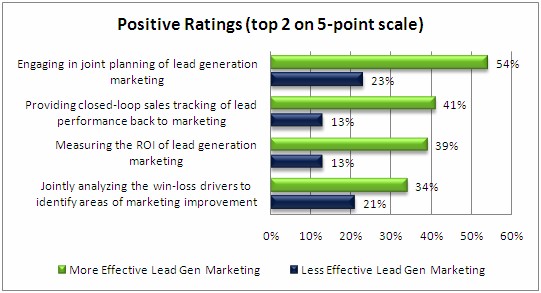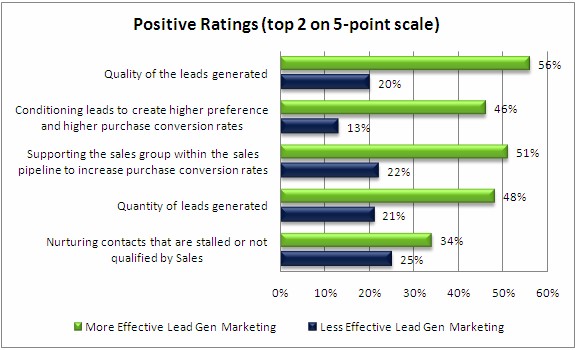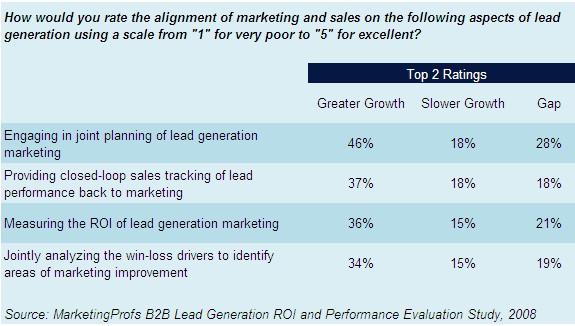Marketers responsible for lead generation are all too familiar with some common challenges—getting closed-loop feedback from the sales organization, measuring marketing effectiveness beyond just lead quantity and cost per lead, and building strong alignment with the sales organization.
As presented in the MarketingProfs' research report, "B-to-B Lead Generation: Marketing ROI and Performance Evaluation Study," effective lead-generation marketing is very much tied to overcoming these challenges to prioritize lead quality over lead quantity.
The research report, released in June 2008, showed that companies that rate their lead-generation marketing as more effective than competitors' were three times as likely to report a strength in closed-loop sales tracking and measuring the ROI (return on investment) of their lead-generation marketing.
More than half of the marketers with more effective lead generation marketing (56%) expect that their sales organizations would rate the quality of leads as positive (top two scores on a 5-point rating scale) compared with just 20% of those with less effective marketing.


Lead quality is critical to managing and improving bottom-line performance. In addition to these research findings, basic ROI analytics can be used to make your case to prioritize quality over quantity and guide your decisions to deliver greater performance and profitability. You ultimately need better insight into the two primary dimensions of quality: average profit per sale and average conversion rates from lead to sale.
With insight into lead quality and ROI, the marketing team can unlock untapped opportunities with...
- Better alignment of the marketing spend to value potential
- Improvements to marketing strategy
- Better tracking and metrics
- Earning buy-in from the sales organization
We'll run through some basic math first to build the support for acting on the strategy, metrics, and alignment opportunities.
Marketing Investment Levels Aligned to Value Potential
Cost per lead is a very commonly used marketing metric (used by 34% of B2B lead-generation marketers, according to our research). It can be an insightful metric, but it is highly dependent on all leads' having the same value and conversion potential, which is rarely the case. If your cost per lead goes up but you bring in better-quality leads with either higher profit per sale or higher conversion rates, it will be a worthwhile investment. Marketing effectiveness can be improved with "value-tiered marketing investments" that align marketing spending with the expected returns for better ROI performance.
For example, you may be marketing to a target audience that has an average profit per sale of $4,000 (based on $16,000 revenue * 25% gross margin) and a lead-to-sale conversion rate of 7%. To achieve an ROI of 25%, the maximum cost per lead is calculated as $224. The calculation is presented below (and here, a more detailed explanation for those mathematically inclined).
Maximum Cost per Lead = ($4,000 / (1 + 25%)) * 7% = $224
But suppose the target audience is made up of three equal-size segments with the following performance patterns:
| Segments | Conversion Rate |
Profit per Sale |
| Segment A |
6% |
$5,000 |
| Segment B |
10% |
$4,000 |
| Segment C |
5% |
$3,000 |
| Total (average) |
7.0% |
$4,000 |
Segment A has the highest value, while Segment B has a highest conversion rate. It does not make sense to manage our marketing investment using the average cost per lead. Instead, we run the basic calculation to determine the maximum cost per lead per segment.
| Segments | Conversion Rate |
Profit per Sale |
Maximum |
| Segment A |
6% |
$5,000 |
$240 |
| Segment B |
10% |
$4,000 |
$320 |
| Segment C |
5% |
$3,000 |
$120 |
| Total (average) |
7.0% |
$4,000 |
$224 |
Now we can see that more marketing can be invested into Segment B based on the higher quality of the lead. In fact, our previous marketing to Segment C that averaged $224 Cost per Lead was actually costing more in marketing than the profits returned and therefore hurting the company's financial performance.
This is a very basic financial analysis that can be replaced with more advanced versions that take into account the sales investment in addition to the marketing investment and multiple stages of conversion rates from initial sales acceptance of leads through the sales pipeline.
The other benefit of improving lead quality is that the cost of sales resources will be reduced as the leads unlikely to convert to a sale are removed from the sales pipeline. In the advanced versions of the ROI analysis, this becomes apparent.
Regardless of the level of sophistication, we have at least established the economic view of why lead quality and targeting are important to drive effectiveness, performance, and ROI. Segmentation of targeted prospects based on the two dimensions of lead quality allows you to invest more in high profit-potential segments and reduce spending with low profit-potential segments.
Improvements in Marketing Strategy
There are a number of key areas of marketing strategy that can benefit with better insight into lead quality. The most significant driver of ROI is targeting, so improvements here are a top priority. Lead-generation marketing can reach a broad audience with many types of marketing tactics. The goal is to concentrate additional tactics and offers on the top segments of prospects. This is where lead scoring and predictive modeling can be used to set the priorities and establish investment levels based on the conversion probability and value probability.
Better marketing conditioning and nurturing of leads prior to the hand off to the sales team improves conversion rates. Improvements in the effectiveness of this stage of marketing can be assessed using lead-to-sale conversion rates and incremental customer value per sale. Once again, a basic ROI calculation can demonstrate how investing in additional marketing touchpoints prior to handing leads off to Sales can generate significant returns from increased revenues.
The focus on narrowing the marketing efforts on fewer but better prospects to deliver higher-quality leads always sparks the same question: "But what if the volumes drop too low?" If you apply the ROI analysis shown above and identify the point of diminishing returns—that is, the point where the cost per lead is too high to reach your ROI target—it is certainly possible that your total lead quantities will decrease. But when you reach the point where your lead-generation marketing will no longer be profitable, quantity will not help. You must then shift your priorities to improving effectiveness with the leads you are already generating. To achieve this effectively, Marketing must be working in step with the sales organization to improve conversion rates within the sales pipeline.
Keep in mind that improving conversion rates in the sales pipeline has very high profit potential, even if lead quantity is not an issue. If only 2% to 10% of leads are converting to closed sales, that means 90% to 98% of the leads are leaking out of the funnel, offering plenty of room from performance improvements. Marketing organizations that are restricted to lead generation with a minimal role in supporting the sales pipeline should look closely at the opportunities here to build the case for better alignment and integration.
As part of your overall funnel management and getting the most value from the leads generated, ROI insight tied to lead quality can also support decisions for Marketing to nurture rejected or stalled leads.
Better Tracking & Metrics
Marketing ROI is driven by three primary drivers of profitability—incremental customer value (ideally long-term profits), lead-to-purchase conversions rate, and cost per sale. Add "total sales volume" to that list and you have the four most critical metrics for managing performance—keeping the company's overall financial performance on track and guiding marketing and sales priorities to reach and exceed goals. These same metrics work at the campaign level to prioritize segments for targeting and guide budget allocation, as addressed earlier in this article.
Other marketing metrics should align to these core metrics to provide greater depth of insight that can be acted upon. For example, a metric such as "average value of first-time buyers" may serve as an early indicator of a likely decline in future revenues if your marketing is now attracting leads from lower-value segments.
To use better metrics that reflect lead quality, you must have better tracking—in particular the closed-loop feedback from the sales organization that captures the lead outcomes such as sales acceptance, funnel progression, and conversion to closed sale.
The ratio of Marketing-qualified leads ("MQLs," which represent the leads that Marketing deems ready to hand over to the sales organization) to Sales-qualified leads ("SQLs," which represent the leads that Sales accepts as qualified for a sales contact) is very important. Marketing can improve this MQL-to-SQL ratio when provided with feedback to understand the drivers of rejected leads and profiles of the accepted leads.
Additional tracking details from the sales organization that can support improvements in lead quality:
- Lead screening reasons (why MQLs are not accepted as SQLs)
- Lead progression rates through key funnel stages to show leakage points
- Average days from lead hand-off to sales contact (reflecting sales capacity and the "freshness" of leads contacted)
- Good reporting on leakage reasons (why they dropped out of the sales pipeline)
- Joint win-loss analysis to assess leads lost late in the sales pipeline
- Analyses of closed sales to provide information on both net close rate and incremental customer value (sometimes available through financial systems instead of sales reporting)
Marketing also has to take responsibility for tracking and maintaining quality data for performance analysis. The Lenskold Group/Kneebone 2008 Marketing ROI & Measurements Study showed that access to data under Marketing's control was a weakness yet had a strong correlation to achieving highly effective and efficient marketing. In particular, Marketing must maintain detailed tracking of outbound and inbound marketing touchpoints to prospects during the lead-generation process. This information is critical to applying more advanced measurements that can properly attribute sales contribution to multiple touchpoints instead of just crediting the most recent lead source.
Earning Sales Buy-in
Simply wishing for, or even requesting, that the sales organization put extra effort into providing tracking information to Marketing is not enough. Marketing must make the case that it can and will act on the information provided. As established at the beginning of this article, lead quality benefits the sales organization as well as the financial performance of the company. Leads with higher conversion rates use Sales resources more efficiently. And higher conversion rates and higher value per sale both contribute to achieving sales goals.
The B-to-B Lead Generation: Marketing ROI and Performance Evaluation Study found that companies growing faster than their competitors had better alignment between Sales and Marketing than companies growing slower than competitors, as shown in the following table:

One of the most effective ways that we have found to break down the barriers between Marketing and Sales is to identify and work with a pilot team within the sales organization. The pilot team is typically a group that sees the potential value of lead quality, or is willing to experiment to improve performance. The tracking efforts are done without major investments into systems infrastructure or organization-wide process changes.
The closed-loop information provided back to Marketing is then applied to improve lead quality from the initial targeting and tactical investments, to Marketing's lead qualification and contribution to the sales pipeline. A basic ROI analysis is used to run scenarios that indicate the key priorities for where additional marketing support can most effectively lead to incremental sales and profitability.
Improving lead-generation marketing is a continuous journey, but it offers significant profit potential.




